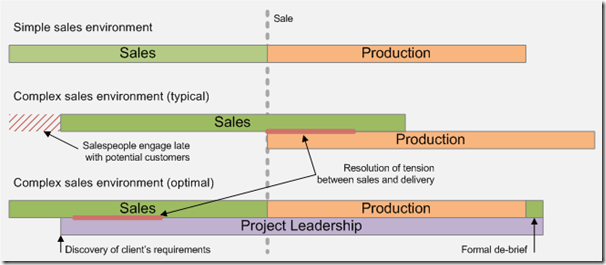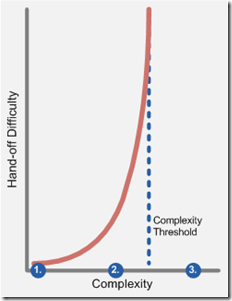The Holy Grail of technical sales: how to disentangle salespeople from production
Whenever we work in a technical-sales environment, this – bar none – is the most valuable idea we bring to the table.
Here’s the most obvious symptom of the problem:
When salespeople make a technical sale, they inevitably become entangled with production. Their involvement in production cannibalizes their (already limited) business-development capacity – leading to the boom-and-bust problem that plagues so many businesses.
To explore the source of this problem – and to uncover its solution – let’s consider these three scenarios.
Scenario 1: simple sales environment
In a simple sales environment, the relationship between sales and production is, well, simple!
The Coca Cola rep assesses a mom-and-pop store’s requirements and dispatches an order to production from her handheld computer. Production can fulfill that order without any recourse to sales.
That means that sales and production can be situated end-to-end with a perfect hand-off of information between them (per example 1, above).
So far, so good.
Scenario 2: complex sales environment (typical)
So, what happens when we’re dealing with complex sales (in a technical environment)? Can we adopt the same structure?
The software company salesperson discusses his client’s unusual problem, conceptualizes a solution and successfully pitches a custom application. He then carefully completes and submits the specification document provided to him by production.
The $64 question is: can production complete and deliver the application without recourse to the salesperson? Intuitively, the answer is no. Production will definitely need to consult with the salesperson during the production process – and it’s likely that the client will need to do likewise.
Imagine what happens if production attempts to resolve this problem (as they often will) by providing salespeople with a more detailed specifications document to complete. If this document grows from 2 pages to 5 – or from 5 to 50 – do you think the problem will be resolved?
You’re right: it won’t. But to make progress here, it’s critical we understand why.
Complexity versus hand-off difficulty
We’ve already discussed that, in a simple environment (like the Coca Cola one), hand-offs are easy. What happens when environments become more complex?
The thing is that, the relationship between complexity and hand-off difficulty happens to be non-linear.
Specifically, as complexity increases past what I call the complexity threshold, hand-off difficulty goes to infinity! In other words there’s a point beyond which hand-offs are not just difficult; they’re impossible.
I’m not aware of a method to calculate the exact location of this threshold, but here’s a rough rule of thumb:
1. Make-to-stock environment: EASY
2. Make-to-order environment: HARD
3. Engineer-to-order environment: IMPOSSIBLE
So, where our software company is concerned, if perfect hand-offs are impossible, salespeople have no choice but to maintain an involvement in production after the sale is won (example 2, above).
Production needs the salesperson involved to resolve the numerous ambiguities in the specifications. And the client needs the salesperson involved too because they don’t feel comfortable that production truly understands their needs.
The good news is that salespeople’s continuing involvement in production resolves the worst of the hand-off problems. The bad news is that this model has two serious shortcomings:
- Because salespeople tend to be busy, time spent in production is time that can’t be spent on business development. Of course, this results in a smaller opportunity pipeline; but the really bad news is that salespeople’s limited capacity tends to cause them to engage later in clients’ buying cycles – at the expense of both margin and deal size (read more about this problem here).
- The resolution of the inevitable tension between sales and production occurs after the sale is made (you promised the client what!!). Of course, this tends not to have positive implications for customer satisfaction (or profitability).
Scenario 3: complex sales environment (optimal)
In identifying the real reason for salespeople’s entanglement in production, at least the direction of the solution to this problem starts to come into focus.
If perfect hand-offs are impossible, the key is not to try and fix them but, rather, to engineer the requirement for them out of the workflow. The third example in the diagram above shows how this can be done. This model introduces a new resource: the project leader.
The project leader is a technical person who is comfortable in the sales environment. This person belongs to neither the sales or the production team. This is because their reason for existence is to manage the interface between these two functions.
The project leader’s primary responsibilities are to:
- Pre-sale: discover the clients’ requirements and design the solution
- Post-sale; oversee (but not manage) production to ensure that the project stays true to the client’s (commercial) expectations
The value of the project leader, becomes more apparent when we track a client engagement from start to finish:
Because the salesperson has been disentangled from production, she now has the capacity to engage early in the client’s buying cycle.
This early engagement results in the first one or two meetings being conceptual in nature.
When the client is ready to brief the vendor on it’s requirements, the salesperson introduces the project leader?
The project leader discovers the client’s requirements, designs a solution and generates a proposal.
The salesperson and the project leader negotiate a resolution to the tension between sales and production (the project leader wants a solution that is deliverable: the salesperson wants one that is saleable). They may even involve the client in this discussion.
Once the client is happy with the solution proposed, the salesperson is responsible for negotiating commercial terms and getting the contract signed.
As soon as the contract is signed, the salesperson exists this engagement (although ideally she will continue to engage with the client on other opportunities).
During the production process, the project leader will chair periodic project-leadership meetings. These meetings will be attended by the client, the production team leader and the project leader. The purpose of each meeting is to maintain the fit between the project plan and the client’s commercial requirements. Major projects tend to drift off-track because (a) some assumptions made during solution-design turn out to be incorrect, (b) the client’s business environment changes during delivery and, (c) the client fails to dedicated the expected resources to the project.
Once the project has been delivered, the project leader will chair a formal debriefing meeting to (a) ensure that the client appreciates that the project was successfully delivered and, (b) create an ideal environment for the salesperson to prospect for new opportunities
In summary, then, this new model delivers the following benefits:
- Salespeople engage earlier with (more) potential clients (as opposed to engaging only when opportunities have degenerated into bidding wars) – which impacts positively on margin and deal size
- The trade-offs between features and price are negotiated prior to the deal being won – which impacts positively on customer satisfaction and profitability
- The project leader takes an active role in maintaining the commercial integrity of the project – which also impacts satisfaction and profitability
Cost justification
When we present this (optimal) model to clients, most are excited. The greatest concern, however, is the impact on cost. There are two reasons why cost tends not to be an issue in reality.
- Most of the activities performed by the project leader in this new model are being performed currently – it’s just that they are shared between sales and production. This means that, in many cases, you can transition to the new model by simply restructuring – without adding personnel. The most common way to achieve this is to convert your more technical salespeople into project leaders – and have your remaining salespeople focus exclusively on business development.
- If you do choose to add new personnel in order to transition to this new model, you must contrast any increase in operating expense with the current opportunity cost of your salespeople’s lack of business-development activity. The bottom line is that, if your salespeople are not worth more to the firm when they are selling than they are when they are performing production-related activities, then they should not be salespeople in the first place.
In practice, when we are helping our clients to make this transition, we take a hard line on the issue of costs. Specifically, our policy is to never propose a transition plan that causes operating expenses to increase in the short term (you’re welcome to use the comments section to ask why!).
In most cases, we achieve this by dramatically reducing the size of the sales team and converting most of the existing salespeople into project leaders. Because SPE always increases the volume of business-development meetings performed by the remaining salespeople by an order of magnitude, 20% of the sales team will perform 200% of the current volume of business-development meetings.
As I mentioned at the outset, this is the most valuable idea we bring to the table whenever we work in a technical (engineer-to-order) environment. In fact, for many firms, fixing the interface between sales and production represents perhaps the most exciting short-term opportunity to develop a competitive advantage.
And this is an advantage that can be sustained for at least as long as competitors insist in maintaining the traditional approach to the structure of the sales environment (where salespeople operate as autonomous agents).

